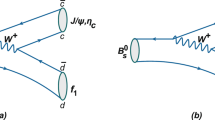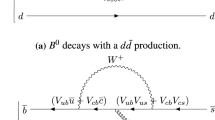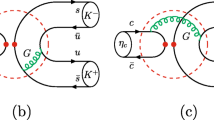Abstract
By using the decay constants and light-cone distribution amplitudes derived from QCD sum-rule method, we calculate the branching ratios of decays B→a 1(1260)η (′) and B→b 1(1235)η (′) in the PQCD factorization approach and find that the charged decays \(B^{-}\to a^{-}_{1}(1260)\eta^{(\prime)}\) have larger branching ratios, which are at the order of \(\mathcal{O}(10^{-6})\), for receiving large contributions from the factorizable emission diagram amplitudes and large decay constant \(f_{a_{1}}=238\pm10~\mathrm{MeV}\) compared with \(f_{b_{1}}\). For the other decays, their branching ratios are at the order of \(\mathcal{O}(10^{-7})\) when the η meson is involved, and \(\mathcal{O}(10^{-8})\) when the η′ meson is involved. For all of the considered decays, the branching ratios of the channels involved η meson are larger than those of the channels involved η′ meson. We also predict the direct, mixing-induced, and total CP-violating asymmetries of the relevant decays.






Similar content being viewed by others
Notes
Certainly, one should employ the decay constant \(f_{b_{1}}\) to define the longitudinal light-cone distribution amplitudes (LCDAs) of the b 1 meson as
 (5)
(5)where \(\mu_{b_{1}}=1/a^{\parallel,b_{1}}_{0}\). \(\mu_{b_{1}}\) is infinite and \(f_{b_{1}}\) vanishes due to G-parity in the SU(3) limit. It is convenient to use the following format:
 (6)
(6)where we have the relation \(f_{b_{1}}=f^{T}_{b_{1}}(\mu)a^{\parallel ,b_{1}}_{0}(\mu)\). This amounts to treating the decay constant of b 1 as \(f^{T}_{b_{1}}\), but it does not mean that \(f_{b_{1}}\) is equal to \(f^{T}_{b_{1}}\).
References
B. Aubert et al. (BABAR Collaboration), Phys. Rev. Lett. 97, 051802 (2006). arXiv:hep-ex/0603050
B. Aubert et al. (BABAR Collaboration), Phys. Rev. Lett. 98, 181803 (2007). arXiv:hep-ex/0612050
B. Aubert et al. (BABAR Collaboration), Phys. Rev. D 75, 111102 (2007). arXiv:hep-ex/0703038
B. Aubert et al. (BABAR Collaboration), Phys. Rev. Lett. 99, 241801 (2007). arXiv:0708.0050 [hep-ex]
B. Aubert et al. (BABAR Collaboration), Phys. Rev. Lett. 99, 241803 (2007). arXiv:0707.4561 [hep-ex]
B. Aubert et al. (BABAR Collaboration), Phys. Rev. Lett. 100, 051803 (2008). arXiv:0709.4165 [hep-ex]
B. Aubert et al. (BABAR Collaboration), Phys. Rev. D 78, 011104 (2008). arXiv:0805.1217 [hep-ex]
K. Abe et al. (Belle Collaboration). arXiv:0706.3279 [hep-ex]
V. Laporta, G. Nardulli, T.N. Pham, Phys. Rev. D 74, 054035 (2006)
G. Calderon, J.H. Munoz, C.E. Vera, Phys. Rev. D 76, 094019 (2007)
H.Y. Cheng, K.C. Yang, Phys. Rev. D 76, 114020 (2007)
W. Wang, R.H. Li, C.D. Lu, Phys. Rev. D 78, 074009 (2008)
X. Liu, H.S. Wang, Z.J. Xiao, L.B. Guo, C.D. Lu, Phys. Rev. D 73, 074002 (2006)
H.S. Wang, X. Liu, Z.J. Xiao, L.B. Guo, C.D. Lu, Nucl. Phys. B 738, 243 (2006)
Z.J. Xiao, D.Q. Guo, X.F. Chen, Phys. Rev. D 75, 014018 (2007)
Z.J. Xiao, Z.Q. Zhang, X. Liu, L.B. Guo, Phys. Rev. D 78, 114001 (2008)
Y.Y. Charng, T. Kurimoto, H.n. Li, Phys. Rev. D 74, 074024 (2006)
C.D. Lu, M.Z. Yang, Eur. Phys. J. C 28, 515 (2003)
C.D. Lu, K. Ukai, M.Z. Yang, Phys. Rev. D 63, 074009 (2001)
T. Kurimoto, H.N. Li, A.I. Sanda, Phys. Rev. D 65, 014007 (2001)
K.C. Yang, Nucl. Phys. B 776, 187 (2007)
T. Feldmann, P. Kroll, B. Stech, Phys. Rev. D 58, 114006 (1998)
T. Feldmann, P. Kroll, B. Stech, Phys. Lett. B 449, 339 (1999)
T. Feldmann, Int. J. Mod. Phys. A 15, 159 (2000)
H.N. Li, S. Mishima, A.I. Sanda, Phys. Rev. D 72, 114005 (2005)
P. Ball, J. High Energy Phys. 9809, 005 (1998)
P. Ball, J. High Energy Phys. 9901, 010 (1999)
P. Ball, R. Zwicky, Phys. Rev. D 71, 014015 (2005)
P. Ball, R. Zwicky, J. High Energy Phys. 0604, 046 (2006)
H.n. Li, H.L. Yu, Phys. Rev. D 53, 2480 (1996)
K. Nakamura et al. (Particle Data Group), J. Phys. G 37, 481 (2010)
CKMfitter Group, http://ckmfitter.in2p3.fr
S. Eidelman et al. (Particle Data Group), Phys. Lett. B 592, 1 (2004)
Acknowledgements
This work is partly supported by the National Natural Science Foundation of China under Grant No. 11147004, and by Foundation of Henan University of Technology under Grant No. 2009BS038.
Author information
Authors and Affiliations
Corresponding author
Rights and permissions
About this article
Cite this article
Zhang, ZQ., Guo, HX., Kang, GS. et al. Study B→a 1(1260)(b 1(1235))η (′) decays in the PQCD approach. Eur. Phys. J. C 73, 2270 (2013). https://doi.org/10.1140/epjc/s10052-012-2270-0
Received:
Revised:
Published:
DOI: https://doi.org/10.1140/epjc/s10052-012-2270-0






